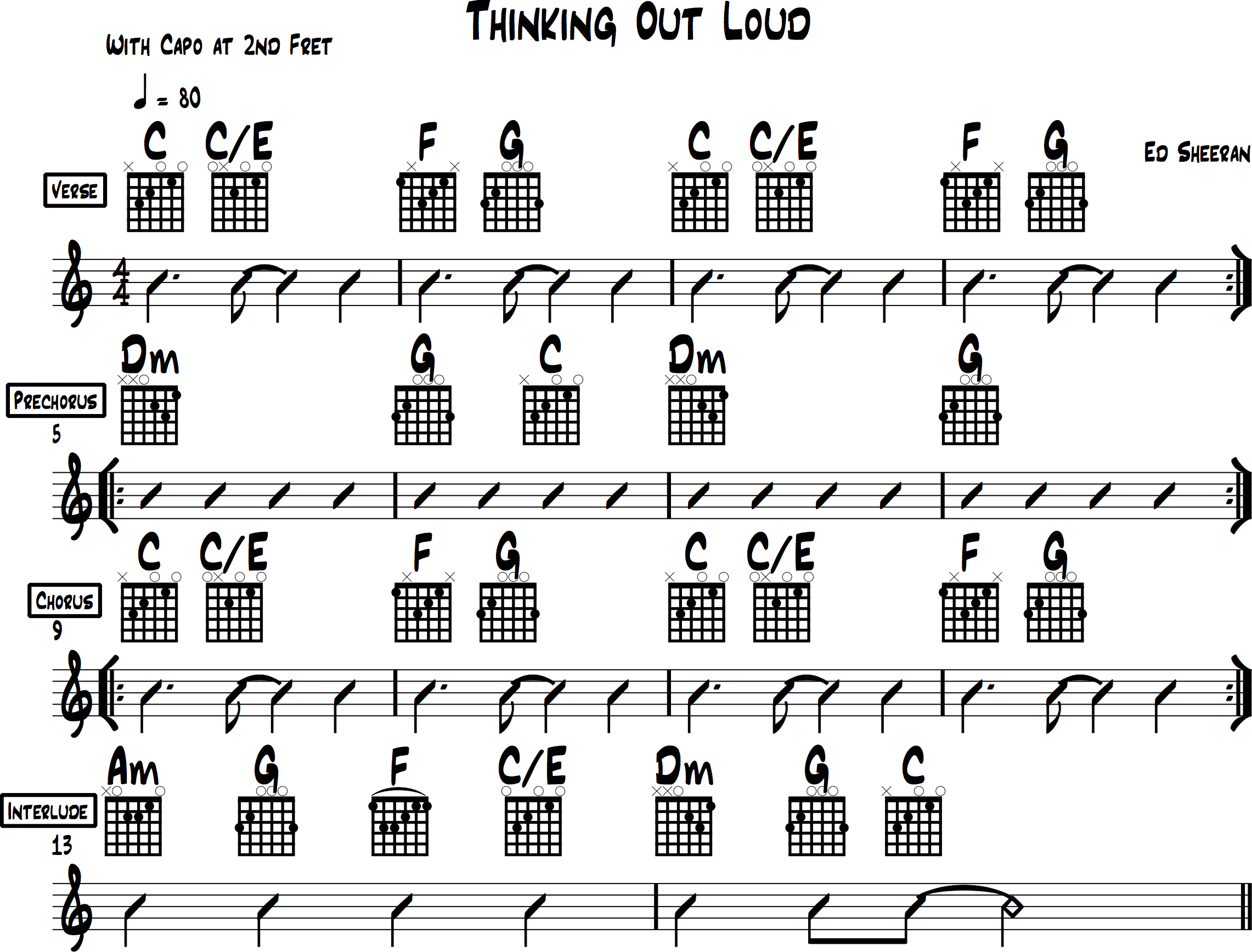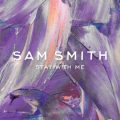 Thinking Out Loud is a song by English singer-songwriter Ed Sheeran, recorded for his second studio album, X (2014). It was written by Sheeran and Amy Wadge, and was produced by frequent collaborator Jake Gosling. It was released in the US on 24 September 2014, serving as the third single from the album. Today we’ll learn the Thinking Out Loud chords and some accompaniment techniques for playing the song.
Thinking Out Loud is a song by English singer-songwriter Ed Sheeran, recorded for his second studio album, X (2014). It was written by Sheeran and Amy Wadge, and was produced by frequent collaborator Jake Gosling. It was released in the US on 24 September 2014, serving as the third single from the album. Today we’ll learn the Thinking Out Loud chords and some accompaniment techniques for playing the song.
Useful links:
Song Specs
Title: Thinking Out Loud
Artist: Ed Sheeran
Songwriters: Ed Sheeran and Amy Wadge
Album: X
Key: C (Capo at 2nd fret, actual key is D)
Tempo: 80
Chord Progression: C–C/E–F–G–Am–Dm
Accompaniment Technique: Open Chords, Basic Fingerstyle with Percussive Strums
Playing Tips
Here are some helpful tips to keep in mind that will help you learn the tune faster while giving you some ideas for how to approach performing it. I provided some useful links above and I’ll take you through the Thinking Out Loud chords, accompaniment patterns, song form, and a chord chart. Everything you need to get started playing this tune.
Thinking Out Loud Chords
| Chords | C | Dm | F | G | Am |
| Progression | i | ii | IV | V | vi |

Thinking Out Loud is the key of D major. However, if we add a capo to the 2nd fret, we can use chords in the key of C major. We’ll be playing in the key of D major but thinking in the key of C. Although D major is not a difficult key for guitarists—and it uses many open-position chords as well—this tune simply sounds better using the C-position chords with a capo.
This is a fun and easy tune that you can quickly add to your repertoire. It’s also a great tune for those venturing into the world of fingerstyle playing and singing while playing. The repetitive nature of the chord progression and accompaniment pattern lend themselves to working on these skills.
Accompaniment Techniques
The rhythmic feel uses a rhythm pattern called the Charleston rhythm—from the popular dance during the 1920s called the “Charleston.” The pattern uses a syncopation on the “and of 2” that, coupled with the chord change, creates motion and interest. The pattern can be a little tricky at first, but once you get it down, it’s repeated throughout the tune providing you with ample opportunity to practice. Here’s the breakdown:
- It’s a 2-bar rhythm pattern.
- Play the C on beat 1.
- Add a percussive strum on beat 2
- Switch to the C/E on the “and” of 2.
- Add a percussive strum on beat 4.
- Then, play the F chord on beat 1 of the next measure.
- Add a percussive strum on beat 2
- Switch to the G on the “and” of 2.
- Add a percussive strum on beat 4.
- Aim for keeping a steady rhythm throughout.

Basic Fingerstyle Technique
Thinking Out Loud is perfect for beginning fingerstyle players. The right hand is notated as follows:
- P = Thumb
- I = Index
- M = Middle
- A = Ring
I find that using a pick to strum the chords can be a little too harsh sounding for the mood of this tune. For that reason, I suggest using your fingers to pluck and strum the Thinking Out Loud chords. Let’s begin by assigning the right-hand fingers to certain strings:
- The Thumb (P) plays the bass note on the 5th and 6th strings (depending on the chord, of course).
- The Index (I) is assigned to the 4th string.
- The Middle (M) is assigned to the 3rd string.
- The Ring (A) is assigned to the 2nd string.
This is the essence of fingerstyle playing, assigning fingers to specific strings. This way, you don’t need to look at the right hand while playing. Once you get used to it, you can “feel” where you are.
I suggest using the finger-plucking technique for the verse and the finger-strumming technique for the pre-chorus. I explain this in more detail in the video.
Percussive Strum
This technique is subtle but adds to the groove and feel of the tune. Here’s how to execute it:
- Use the same finger assignments as described above.
- Finger-pluck the chord on Beat 1.
- On Beat 2, bring the fingers back to their assigned strings creating a muted strum.
- Finger-pluck the next chord on the “and of Beat 2”.
- On Beat 4, bring the fingers back to their assigned strings creating a muted strum.
Thinking Out Loud Chords Chart
I’ve included a chord chart, which is a simple road map that shows you:
- The overall arrangement of the song.
- A section by section breakdown of the song.
- Each chord and how long to play it for.
If you don’t read music, please don’t be intimidated. This is a cheat sheet that can help you get through the tune quickly and easily. I find it indispensable for learning songs and I can also hand it to a seasoned musician and they can follow along without any problems.
Song Form
- Verse: A 4-measure section that repeats- the two measure C–C/E–F–G chord riff is played twice.
- Pre-chorus: A 4-measure section that repeats: Measure 1 is Dm for 4 beats, Measure 2 is G for 2 beats and C for 2 beats, Measure 3 is Dm for 4 beats, and Measure 4 is G for 4 beats.
- Chorus: A 4-measure section that repeats and is the same as the Verse.
- Interlude: A 2-bar descending chord progression, Am–G–F–C/E–Dm–G–C.
Once you become familiar with chord charts, you’ll never want to go back. It’s just easier to see where you’re going when you have a map. And, it’s especially helpful when you’re not familiar with the song or there’s a section of the song that you don’t remember (Bridges and Interludes are notorious for surprising players and derailing a song’s performance). So, heads up, this tune has an Interlude and it’s used as a Tag at the end of the tune.

Wrap-up
I hope that you’ve enjoyed learning the Thinking Out Loud chords and if you haven’t checked out any classic R&B and Motown music then I encourage you to do so. It’s nice to see where today’s artists get their inspiration from and you may discover a new world of music that may motivate you to explore a new direction.
I appreciate you checking out this lesson. Thank you for hanging with me and I’ll see you next time.







